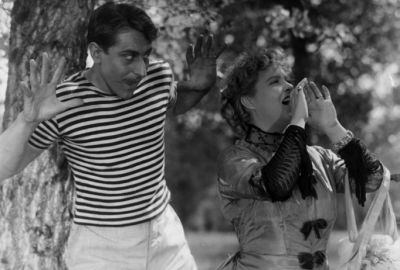
UNE PARTIE DE CAMPAGNE
(La scampagnata, Francia/1936) R.: Jean Renoir. D.: 40'. V. francese. Digitale
T. it.: La scampagnata. Sog.: dall'omonimo racconto di Guy de Maupassant. Scen.: Jean Renoir. F.: Claude Renoir. M.: Marguerite Houllé-Renoir. Scgf.: Robert Gys. Mus.: Joseph Kosma. Ass. regia: Yves Allégret, Jacques Becker, Jacques B. Brunius, Henri Cartier-Bresson, Claude Heymann, Luchino Visconti. Int.: Sylvia Bataille (Henriette Dufour), Georges Saint-Saëns [Georges Darnoux] (Henri), Jane Marken (Juliette Dufour), André Gabriello (Cyprien Dufour), Jacques Borel [Jacques B. Brunius] (Rodolphe), Paul Temps (Anatole), Gabrielle Fontan (la nonna), Jean Renoir (papà Poulain), Marguerite Houllé-Renoir (la cameriera), , Georges Bataille (seminarista) Henri Cartier-Bresson (seminarista), Pierre Lestringuez (il prete), Alain Renoir (un giovane pescatore). Prod.: Pierre Braumberger per Panthéon..
DCP. D.: 40'. Bn. Versione francese / French version
Da: Les Films du Jeudi, Les Films du Panthéon e Cinémathèque Française per concessione di Ripley's Film
Restaurato e digitalizzato nel 2014 da Les Films du Jeudi, Les Films du Panthéon e Cinémathèque française con il supporto di CNC e Fonds Culturel Franco-Américain - DGA MPA SACEM WGAW / Restored and digitalized in 2014 by Les Films du Jeudi, Les Films du Panthéon and Cinémathèque française with the support of CNC and of the Franco-American Cultural Fund - DGA MPA SACEM WGAW
Une partie de campagne è uno dei più riusciti esempi dello stile espressivo che Renoir perfezionò nel corso degli anni Trenta: movimenti di macchina che possono o meno coincidere con il punto di vista di uno dei personaggi, primi piani che esprimono l'ambiguità dei sentimenti, composizioni in profondità di campo che rivelano molteplici livelli narrativi, atmosfere che dissimulano strutture di classica simmetria, bellezza lirica minata dal lato oscuro delle passioni, comunque controllate dalle convenzioni sociali. Mai come in Une partie di campagne Renoir seppe reinventare le eredità del naturalismo e dell'impressionismo, fondendole tra loro in un linguaggio del tutto personale. Eppure il regista fu costretto ad abbandonare il film prima di averlo terminato. Une partie de campagne venne distribuito nel 1946, dieci anni dopo le riprese, dal produttore Pierre Braunberger, che autorizzò Marguerite Houllé-Renoir, montatrice e compagna del regista negli anni Trenta, a montare il film e Joseph Kosma, autore delle musiche di La grande illusione, La Marsigliese (1937) e La Bête humaine (1938), a comporne la colonna musicale. Renoir, che viveva a Los Angeles, diede il proprio consenso senza neppure aver visto il risultato finale.
Tratto dal racconto di Maupassant, il film, come risulta dai documenti di lavorazione di Renoir, avrebbe dovuto essere un mediometraggio poco più lungo di quanto sia in realtà. Iniziato come progetto di modeste dimensioni, da realizzare in esterni insieme alla famiglia e agli amici nelle vicinanze della casa di campagna di Renoir, dove il regista aveva girato il suo primo film, La Fille de l'eau, e dove suo padre aveva dipinto quadri memorabili, il film si trasformò in un costoso progetto della durata di tre settimane, con la troupe in balia d'un maltempo che mise a dura prova i rapporti personali. La pioggia, tuttavia, si rivelò uno dei felici incidenti della carriera di Renoir, che riscrisse la sceneggiatura del film in modo che il temporale entrasse a far parte della vicenda. Le riprese erano quasi terminate quando Renoir e Sylvia Bataille litigarono e il regista abbandonò il film per iniziare le riprese di Le Bas-fonds.
Janet Bergstrom
Une partie de campagne is one of the most beautiful examples of a unique mode of cinematic expression that Renoir perfected during the 1930s: a wandering camera that may or may not coincide with a character's perspective in the course of its movements, close shots that convey the ambiguity of characters' emotions, compositions in depth that reveal two or three levels of narrative attention, ambiance and incidental activities that disguise classically symmetrical story structures, lyrical beauty undermined by the dark side of human desire as governed by social conventions. Renoir reinvented and combined the heritage of Naturalism and Impressionism in his own idiom and nowhere better than in Une partie de campagne. What a paradox to learn that Renoir left the production before it was finished. Une partie de campagne was released in 1946, ten years after it was shot, by producer Pierre Braunberger who added two titles to bridge gaps in the story and authorized Marguerite Houllé-Renoir, Renoir's editor and companion throughout the 1930s, to edit the film and Joseph Kosma, composer for La Grand illusion, La Marseillaise and La Bête humaine, to write the music. By then Renoir was living in Los Angeles as an American citizen. He consented after the fact and without seeing the film.
Partie de campagne, as de Maupassant's story and Renoir's working documents were titled, was intended to be a medium-length film, not much longer than its current length. What started as a small project to be shot on location with family and friends for about a week near Renoir's country home in Marlotte, where he had made his first film La Fille de l'eau and where his father had created memorable paintings, turned into an expensive three weeks dominated by rain and waiting for the sun to appear, straining personal relationships. But bad weather became one of the many happy accidents in Renoir's career. He rewrote the script and retook shots to make rain part of the story. The impression the film leaves on us is inseparable from this dimension. Shooting was nearly complete when Sylvia Bataille and Renoir had a fight, and the director left to begin Les Bas-fonds.
Janet Bergstrom

Tariffe:
Aria condizionata
Accesso disabili
Tel. 051 522285











